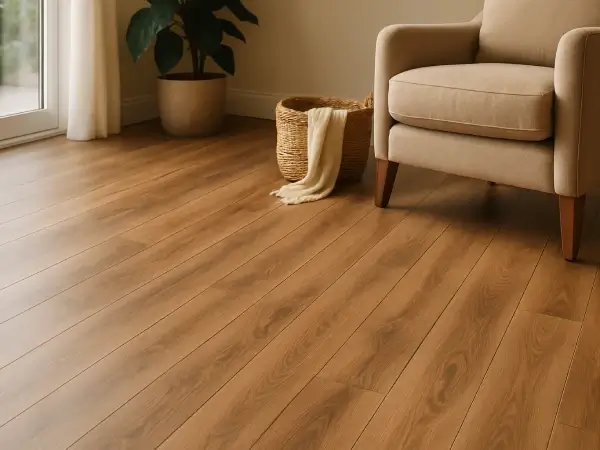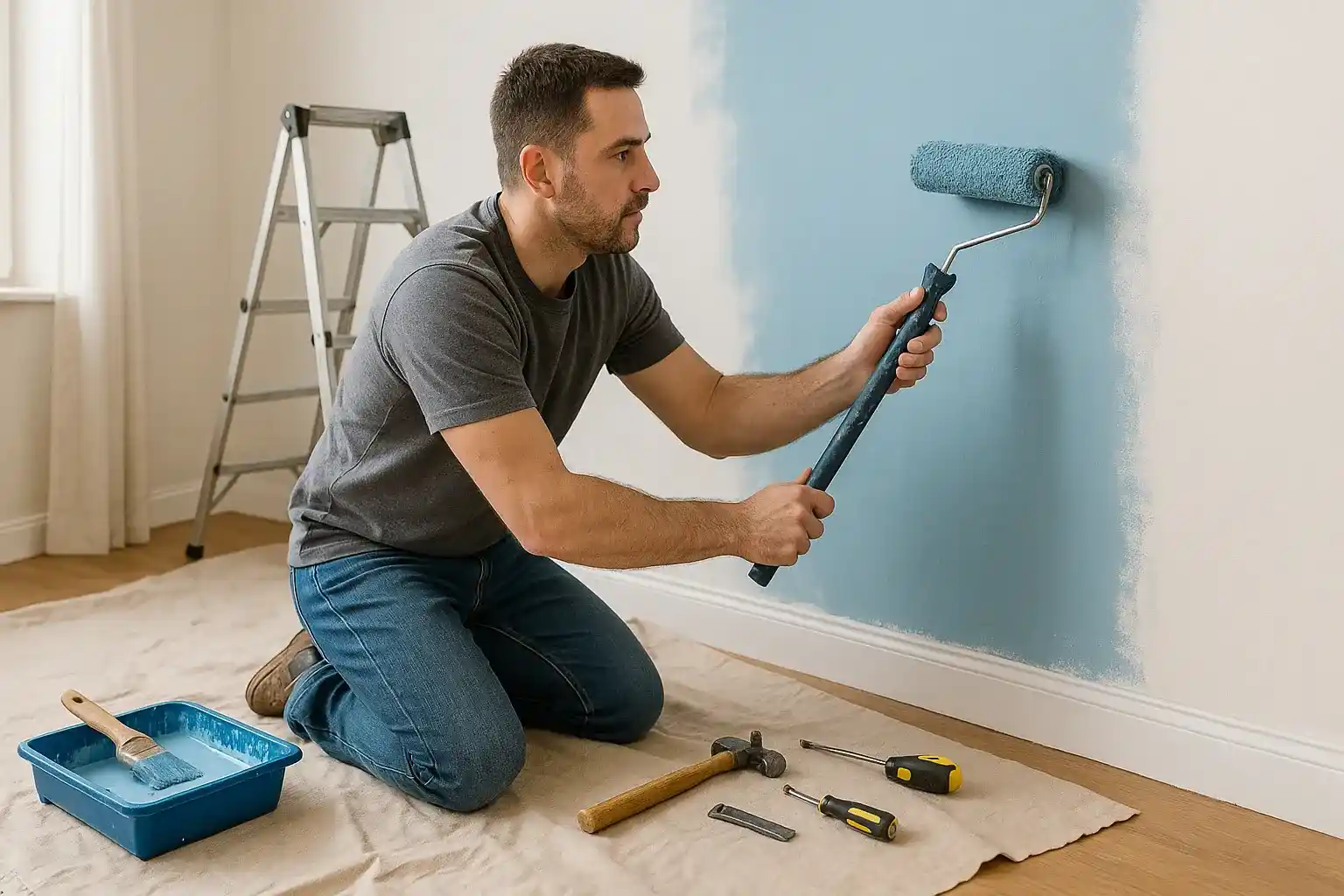Choose LVP for water resistance, hardwood for longevity, or laminate for affordability based on your specific needs.
Use our live calculator below to get your exact flooring cost in seconds.
Luxury Vinyl Plank (LVP)

Luxury Vinyl Plank, or LVP, represents the latest evolution in vinyl flooring technology. Unlike traditional vinyl, LVP features a multi-layer construction that includes a rigid core, realistic photographic layer, and protective wear layer. This innovative design has made LVP one of the fastest-growing flooring options in the market.
Key Features of LVP
- Waterproof: Unlike hardwood and laminate, LVP is completely waterproof, making it ideal for bathrooms, kitchens, and basements
- Realistic Appearance: Advanced printing technology creates incredibly realistic wood and stone patterns
- Durability: Resistant to scratches, dents, and stains with proper wear layers
- Comfort: Softer underfoot compared to hardwood and laminate
- Easy Installation: Many LVP products feature click-lock systems for DIY installation
Pros of LVP
- 100% waterproof - perfect for moisture-prone areas
- Extremely durable and scratch-resistant
- Lower cost than hardwood while maintaining premium appearance
- Easy to clean and maintain
- Can be installed over most existing floors
- Excellent sound absorption
- Warm underfoot and comfortable to walk on
Cons of LVP
- Shorter lifespan compared to hardwood (10-25 years)
- Cannot be refinished like hardwood
- May fade over time with direct sunlight exposure
- Some lower-quality options may have off-gassing concerns
- May not add as much resale value as hardwood
Calculate Your Flooring Costs
Use our comprehensive flooring calculator to compare costs between LVP, hardwood, and laminate. Get detailed estimates including materials, installation, and long-term maintenance expenses.
Calculate Flooring CostsHardwood Flooring
Hardwood flooring has been a symbol of quality and elegance for centuries. Made from solid wood planks, hardwood offers timeless beauty and exceptional durability that can last for generations with proper care. Available in various species, grades, and finishes, hardwood provides unmatched customization options.
Key Features of Hardwood
- Natural Beauty: Each plank features unique grain patterns and natural variations
- Refinishable: Can be sanded and refinished multiple times to restore appearance
- Longevity: With proper maintenance, hardwood can last 50-100 years
- Value Addition: Typically increases home resale value
- Variety: Available in numerous wood species, colors, and finishes
Pros of Hardwood
- Unmatched natural beauty and character
- Can be refinished multiple times to restore appearance
- Extremely long lifespan (50-100 years)
- Increases home resale value
- Hypoallergenic and doesn't trap dust or allergens
- Available in countless species, colors, and finishes
- Classic appeal that never goes out of style
Cons of Hardwood
- Highest initial cost among the three options
- Vulnerable to moisture damage and humidity
- Requires regular maintenance and refinishing
- Can be scratched and dented more easily
- Not suitable for below-grade installations
- Professional installation typically required
- May fade or change color over time
Laminate Flooring
Laminate flooring was developed as an affordable alternative to hardwood, offering the look of wood at a fraction of the cost. Made from multiple layers of synthetic materials bonded together, laminate provides durability and easy maintenance while maintaining an attractive appearance.
Key Features of Laminate
- Cost-Effective: Most affordable option among the three
- Durability: Resistant to scratches, fading, and wear
- Easy Installation: Click-lock systems make DIY installation possible
- Low Maintenance: Requires minimal upkeep compared to hardwood
- Variety: Available in many styles, including wood and stone looks
Pros of Laminate
- Most affordable flooring option
- Highly resistant to scratches and wear
- Easy to clean and maintain
- Quick and simple installation
- Available in countless styles and colors
- Good for high-traffic areas
- Resistant to fading from sunlight
Cons of Laminate
- Not waterproof - can be damaged by moisture
- Cannot be refinished like hardwood
- Shorter lifespan (10-20 years)
- May sound hollow when walked on
- Less authentic appearance compared to real wood
- May not add significant resale value
- Can be slippery when wet
Side-by-Side Comparison
| Feature | LVP | Hardwood | Laminate |
|---|---|---|---|
| Cost per sq ft | $2-7 | $8-25 | $1-5 |
| Lifespan | 10-25 years | 50-100 years | 10-20 years |
| Water Resistance | 100% waterproof | Poor | Moderate |
| Scratch Resistance | Excellent | Good | Excellent |
| Installation Difficulty | Easy | Difficult | Easy |
| Maintenance | Low | High | Low |
| Resale Value | Moderate | High | Low |
Cost Analysis
When comparing flooring costs, it's important to consider both initial expenses and long-term costs including maintenance, repairs, and replacement.
Initial Costs
- Laminate: $1-5 per square foot (most affordable)
- LVP: $2-7 per square foot (mid-range)
- Hardwood: $8-25 per square foot (most expensive)
Installation Costs
- Laminate: $2-8 per square foot (DIY-friendly)
- LVP: $3-10 per square foot (DIY-friendly)
- Hardwood: $6-15 per square foot (professional recommended)
Long-term Costs
While hardwood has the highest initial cost, its long lifespan and ability to be refinished can make it more cost-effective over time. LVP offers a good balance of initial cost and durability, while laminate provides the lowest upfront cost but may need replacement sooner.
Durability and Lifespan
Durability is a crucial factor when choosing flooring, especially for busy households with children and pets.
Hardwood Durability
Hardwood is naturally durable but can be scratched and dented. However, its ability to be refinished makes it the longest-lasting option. With proper care, hardwood can last 50-100 years, making it a true investment in your home.
LVP Durability
LVP excels in durability with excellent resistance to scratches, dents, and moisture. The wear layer protects against daily wear and tear, making it ideal for high-traffic areas. While it can't be refinished, quality LVP can last 10-25 years.
Laminate Durability
Laminate is highly resistant to scratches and wear, making it suitable for busy households. However, its vulnerability to moisture and inability to be refinished limits its lifespan to 10-20 years.
Installation Comparison
Installation requirements vary significantly between the three flooring types, affecting both cost and timeline.
LVP Installation
LVP installation is relatively straightforward, especially with click-lock systems. It can be installed over most existing floors and requires minimal subfloor preparation. DIY installation is possible for experienced homeowners.
Hardwood Installation
Hardwood installation is the most complex and typically requires professional installation. It needs a proper subfloor and acclimation period. Installation can take several days and may require the home to be vacated during the process.
Laminate Installation
Laminate installation is the easiest of the three, with click-lock systems making it very DIY-friendly. It requires minimal tools and can often be installed in a single day for smaller rooms.
Maintenance Requirements
Maintenance needs vary significantly between flooring types and should factor into your decision-making process.
Hardwood Maintenance
- Regular sweeping and mopping with wood-safe cleaners
- Periodic refinishing every 10-15 years
- Protection from furniture scratches and moisture
- Humidity control to prevent warping
- Immediate cleanup of spills to prevent damage
LVP Maintenance
- Simple sweeping and mopping
- No special cleaners required
- No refinishing needed
- Easy spot cleaning for spills
- Minimal ongoing maintenance
Laminate Maintenance
- Regular sweeping and damp mopping
- Avoid excessive water
- No refinishing possible
- Protection from moisture damage
- Simple cleaning routine
Room-Specific Recommendations
Different rooms have different requirements, and your flooring choice should reflect the specific needs of each space.
Kitchens
Best Choice: LVP - Its waterproof nature makes it perfect for kitchens where spills are common. The realistic appearance provides the look of hardwood without the maintenance concerns.
Bathrooms
Best Choice: LVP - The only waterproof option among the three, making it ideal for bathrooms where moisture is constant.
Living Rooms
Best Choice: Hardwood or LVP - Hardwood adds value and elegance, while LVP offers durability and easy maintenance. Consider your budget and lifestyle when choosing.
Bedrooms
Best Choice: Any of the three - Personal preference and budget typically drive this decision. Hardwood adds warmth, LVP offers comfort, and laminate provides affordability.
Basements
Best Choice: LVP - Its waterproof nature and ability to handle moisture make it the only suitable option for below-grade installations.
Environmental Impact
Environmental considerations are increasingly important when choosing flooring materials.
Hardwood Environmental Impact
Hardwood is a natural, renewable resource when sourced responsibly. Look for FSC-certified products to ensure sustainable harvesting. Hardwood is biodegradable and can be recycled or repurposed.
LVP Environmental Impact
LVP is made from synthetic materials and may contain chemicals. However, many manufacturers are developing more eco-friendly options with recycled content and reduced VOC emissions. Look for low-VOC and phthalate-free options.
Laminate Environmental Impact
Laminate is made from wood byproducts and synthetic materials. While it uses less virgin wood than hardwood, it's not biodegradable. Some manufacturers offer products with recycled content and low-VOC emissions.
Making Your Decision
Choosing between LVP, hardwood, and laminate requires careful consideration of multiple factors. Here's a systematic approach to help you decide:
Consider Your Budget
If budget is your primary concern, laminate offers the lowest initial cost. If you can afford a higher upfront investment, hardwood provides the best long-term value. LVP offers a good middle ground.
Evaluate Your Lifestyle
Consider your household's activity level, presence of children and pets, and maintenance preferences. High-traffic areas benefit from LVP or laminate, while formal spaces may warrant hardwood.
Assess Your Space
Consider the room's moisture levels, traffic patterns, and existing conditions. Moisture-prone areas require LVP, while dry areas can accommodate any option.
Think Long-term
Consider how long you plan to stay in your home and your resale goals. Hardwood typically adds the most resale value, while LVP offers good durability for long-term use.
Remember, there's no one-size-fits-all answer. The best flooring choice depends on your specific circumstances, preferences, and requirements. Take the time to research and consider all factors before making your final decision.


Comments
Loading comments...
Leave a Comment